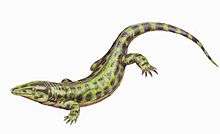Tseajaia
| Tseajaia Temporal range: Permian | |
|---|---|
 | |
| Tseajaia life reconstruction | |
| Scientific classification | |
| Kingdom: | Animalia |
| Phylum: | Chordata |
| Order: | †Diadectomorpha |
| Family: | †Tseajaiidae |
| Genus: | †Tseajaia Vaughn, 1964 |
Tseajaia is an extinct genus of tetrapod. It was an anthracosaurian that lived in the Permian of North America.[1] The skeleton is that of a medium-sized, rather advanced reptile-like amphibian. In life it was about 1 metre (3 ft) long and may have looked vaguely like an iguana, though slower and with a more amphibian foot without claws. The dentition was somewhat blunt, indicating herbivory or possibly omnivory.
Phylogeny
Tseajaia was described from a single, fairly complete specimen and was given its own family by Robert L. Carroll. It was originally thought to be a Seymouriamorph.[2] Additional finds allowing for a better taxonomic analysis indicate they belong in the Diadectomorpha, as the sister group to the large and more derived Diadectidae. Tseajaia itself being a fairly generalized form, gives a reasonable indication of the build and looks of the closest relatives of the amniotes.[3][4]
References
- ↑ Time Traveler: In Search of Dinosaurs and Other Fossils from Montana to Mongolia by Michael Novacek
- ↑ Moss, J.L. (1972): The morphology and phylogenetic relationships of the Lower Permian tetrapod Tseajaia campi Vaughn (Amphibia: Seymouriamorpha). University of California Publications in Geological Sciences, vol 98, pp 1-72.
- ↑ Kissel, R. (2010). Morphology, Phylogeny, and Evolution of Diadectidae (Cotylosauria: Diadectomorpha). Toronto: University of Toronto Press. p. 185. hdl:1807/24357.
- ↑ Berman, D.S, Sumida, S.S., and Lombard, R.E. (1992): Reinterpretation of the temporal and occipital regions in Diadectes and the relationship of diadectomorphs. Journal of Paleontology no 66: pp 481–499.
External links
- Tseajaia in the Paleobiology Database

